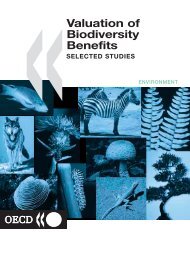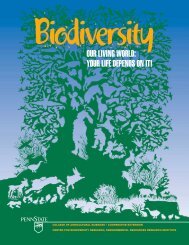Untitled
Untitled
Untitled
- No tags were found...
Create successful ePaper yourself
Turn your PDF publications into a flip-book with our unique Google optimized e-Paper software.
Ochang Branch InstituteRESEARCH AREASKorea National PrimateResearch CenterDevelopment of disease modelsConstructing disease models for incurable primate diseases, which have metabolicpathways most similar to man, and thus developing new drugs and applications for organand regenerative researchDevelopmental biotechnologies and applicationsEstablishing cell resources, including embryonic stem cells and a variety of tissue cells,and applying them to cell therapies, nuclear transfers, and the study of molecularmechanismsRESEARCHERSKyu-Tae Chang changkt@kribb.re.krDeveloping cell and tissue resources derived from nonhumanprimates and conducting research for theirapplicationsDeveloping new breeder miniature pigs for research anddevelopment of bio-organsEkyune Kim kimek@kribb.re.krStudy on the functional relationship of membraneproteins involved in mammalian fertilizationDown-regulation of membrane proteins throughendocytosis mechanismSang-Hyun Kim skim@kribb.re.krMicrobiological monitoring of specific-pathogen freeanimalsStructure / function studies of outer membrane vesiclesSun-Uk Kim sunuk@kribb.re.krStem cell research in mammalsReproductive developmental biotechnologySang-Rae Lee srlee@kribb.re.krMaintaining quality standards of primate resources bySPF health monitoringDevelopment of neuronal disease models (stroke,dementia, Parkinson's disease) with non-humanprimatesJae-Won Huh huhjw@kribb.re.krHuman and non-human primate comparative genomics /Primate molecular genetics / PrimatologyIdentification and molecular characterization of primategenesRESEARCH AREASAcquisition, propagation and distribution of specificpathogen free (SPF) primate resourcesAcquiring and distributing SPF primate resourcesto industrial, academic and research institutionsStandardization in handling of and regulating labRequirements for primate researchMaintaining quality standards of primate resources bymonitoring bacteria, viruses and other general healthparametersEstablishing a standard operating procedure (SOP) byproviding guidelines for the breeding and management ofprimate resources at the international levelXenotransplantation researchTransplanting organs (e.g. pancreatic islet, heart) fromtransgenic germ-free pigs into SPF primates andanalyzing the efficacy and safety of the organstransplantedRegenerative medical research and applicationsUsing primate disease models in cell therapy and genetherapy research, and evaluating their efficacy and safetyfor the treatment of incurable diseasesPreclinical efficacy assessments of newly-developeddrug candidatesApplying various biodrugs and biomaterials to SPFprimates to evaluate efficacyEvaluation of immunogenicity and safety of vaccinecandidatesTesting and assessing the immunogenicity, efficacy andsafety of AIDS and various other vaccinesDirector Kyu-Tae ChangT + 82-43-240-6300F +82-43-240-6309E changkt@kribb.re.krMolecular identification and characterization of non-human primate genesInvestigation of molecular mechanisms of gain and loss of genes in various primatesCollaboration and support for nationwide non-institutional research involving primatesProviding specialized technologies and information about primate care and facilities toother researchers, and conducting collaborative research for the development of relatedtechnologiesACHIEVEMENTSAcquisition of primate resourcesPrimates provide valuable opportunities in providing non-human physiological andanatomical data required for biomedical research and applications. The NPRC currentlyhouses six types of SPF primates: rhesus monkeys, cynomolgus monkeys, African greenmonkeys, Japanese monkeys, squirrel monkeys and common marmosets - a total of 209animals.Transfer of primate-related resources and techniques to national partners of industrial,academic and research institutionsThe NPRC shares its primate-related expertise with researchers nationwide, in fields suchas neuroscience, pharmacokinetics, etc. We provide services for the upkeep of SPFprimates, including microbiological monitoring, quarantine and maintenance workshops,and train the personnel (e.g. veterinarians and breeders) who work with primates.Collaboration with national and international research teamsWe conducted collaborative studies in various fields, including xenotransplantation andthe pharmacokinetic evaluation of therapeutic drugs against aplastic anemia. Forthe introduction of the baboon monkey, we cooperated with the Washington, Tulane, andSouthwest National Primate Research Centers, and are currently collaborating withworld-renown researchers in embryo implantation and development. We are also workingwith domestic companies for the development of mini-pigs useful in organxenotransplantation.SELECTED PUBLICATIONSKyu-Tae Chang (Corresponding) Biochem Biophys Res Commun. 403(2):167-71.Implication of mouse Vps26b-Vps29-Vps35 retromer complex in sortilin traffickingKyu-Tae Chang (Corresponding) BMC Genomics. 11:427.Full-length cDNA sequences from Rhesus monkey placenta tissue: analysis and utility forcomparative mappingKyu-Tae Chang (Corresponding) FEMS Immunol Med Microbiol. 58(3):412-20.Shiga toxin A subunit mutant of Escherichia coli O157:H7 releases outer membranevesicles containing the B-pentameric complexThe NPRC was established within KRIBB as a major national infrastructure component to support industrial, academic and researchinstitutions in the development of xenotransplant organs, providing animal models for research in regenerative medicine andincurable diseases, and evaluating the preclinical trials of new drug candidates.Kyu-Tae Chang (Corresponding) Genomics. 96(5):266-71.Bioinformatic analysis of TE-spliced new exons within human, mouse and zebrafishgenomesKyu-Tae Chang (Co-corresponding) J Pineal Res. 49(3):201-9.Melatonin plus exercise-based neurorehabilitative therapy for spinal cord injury68 KRIBB Annual Report 2010KRIBB Annual Report 2010 69












